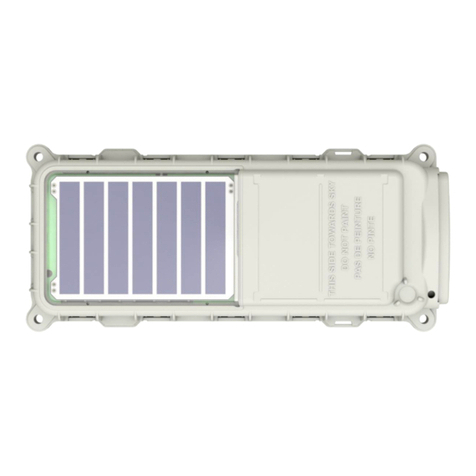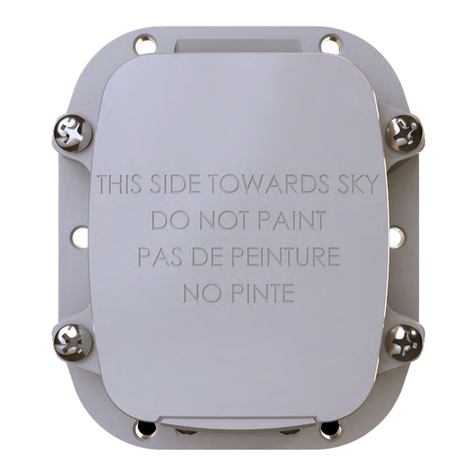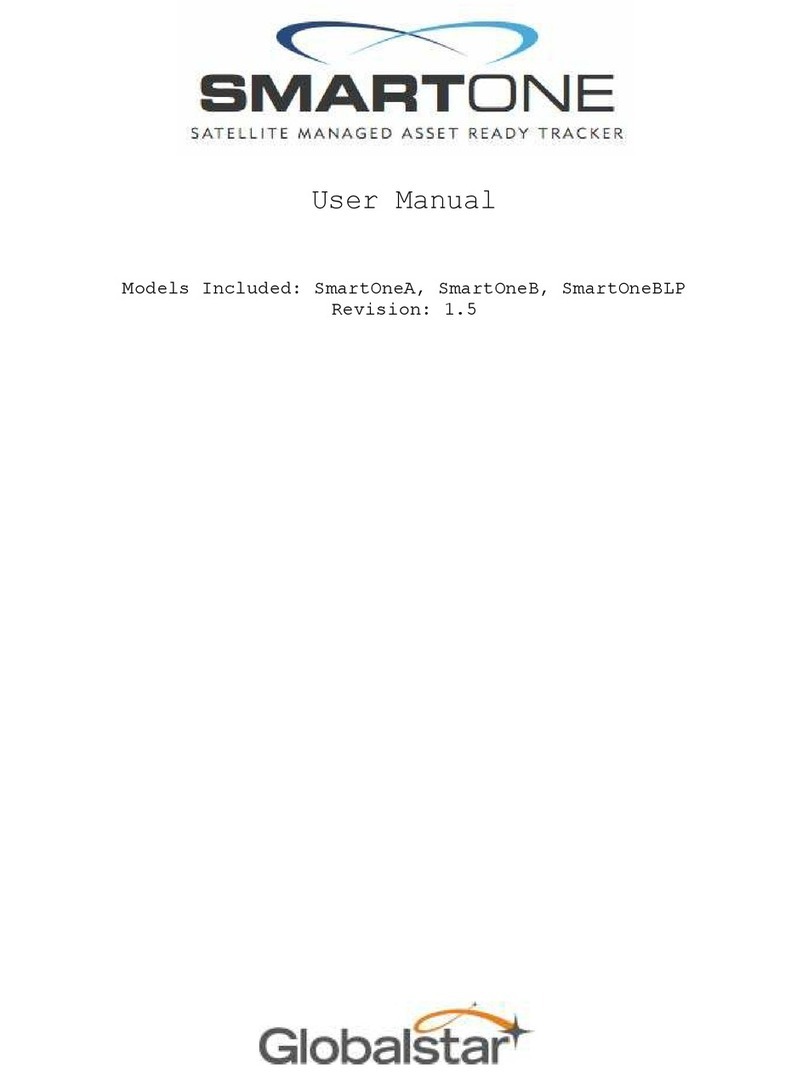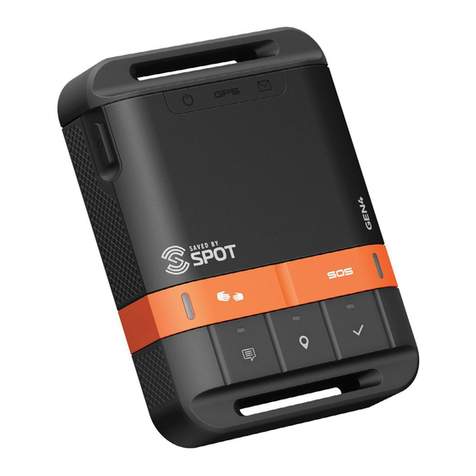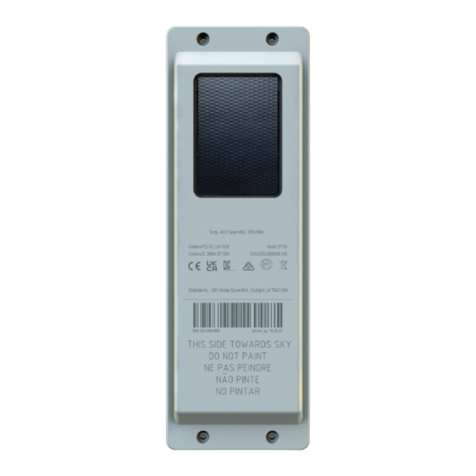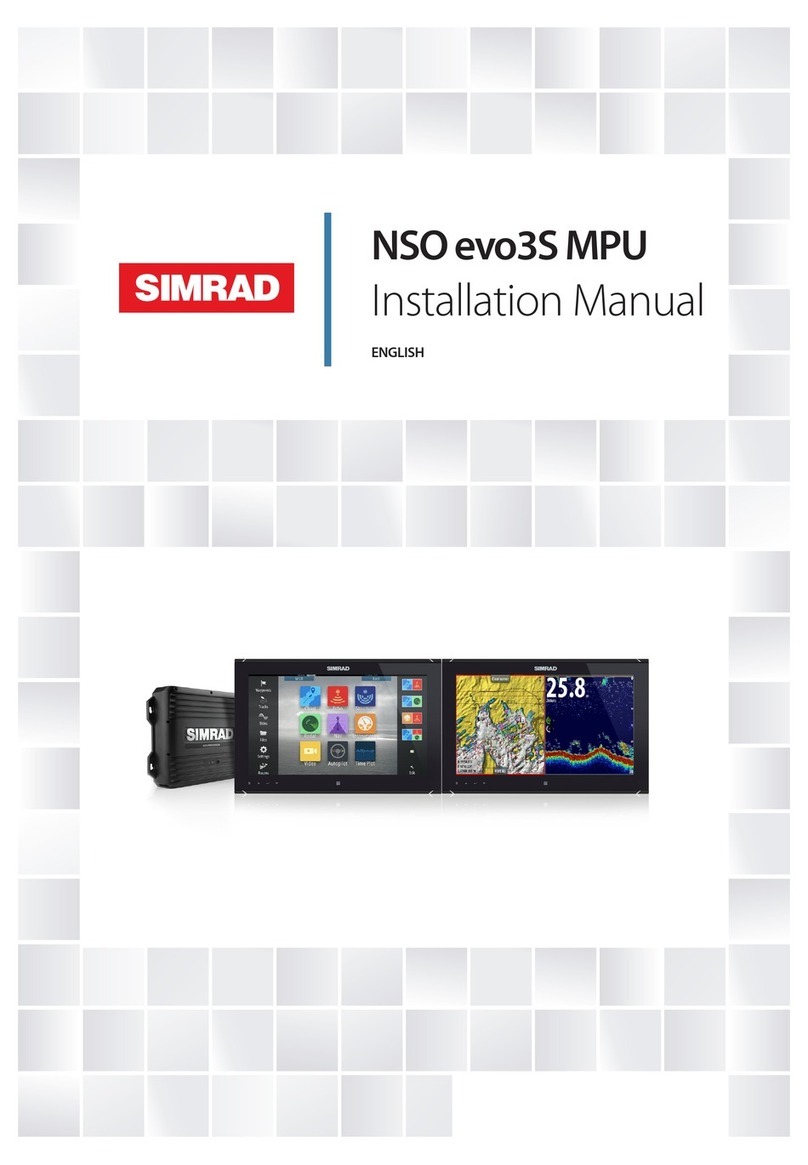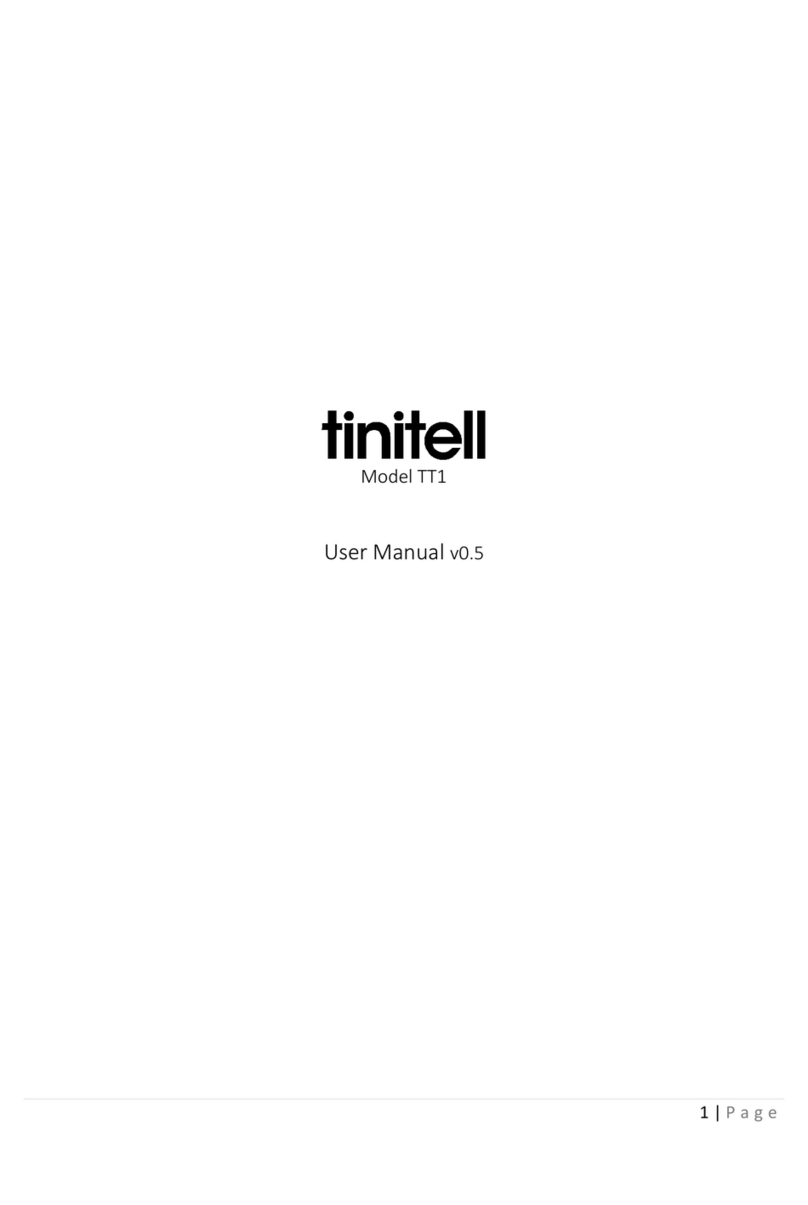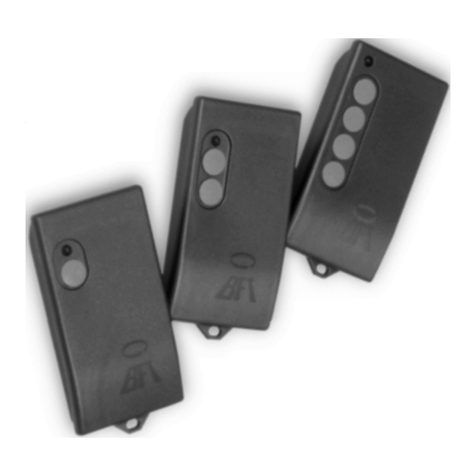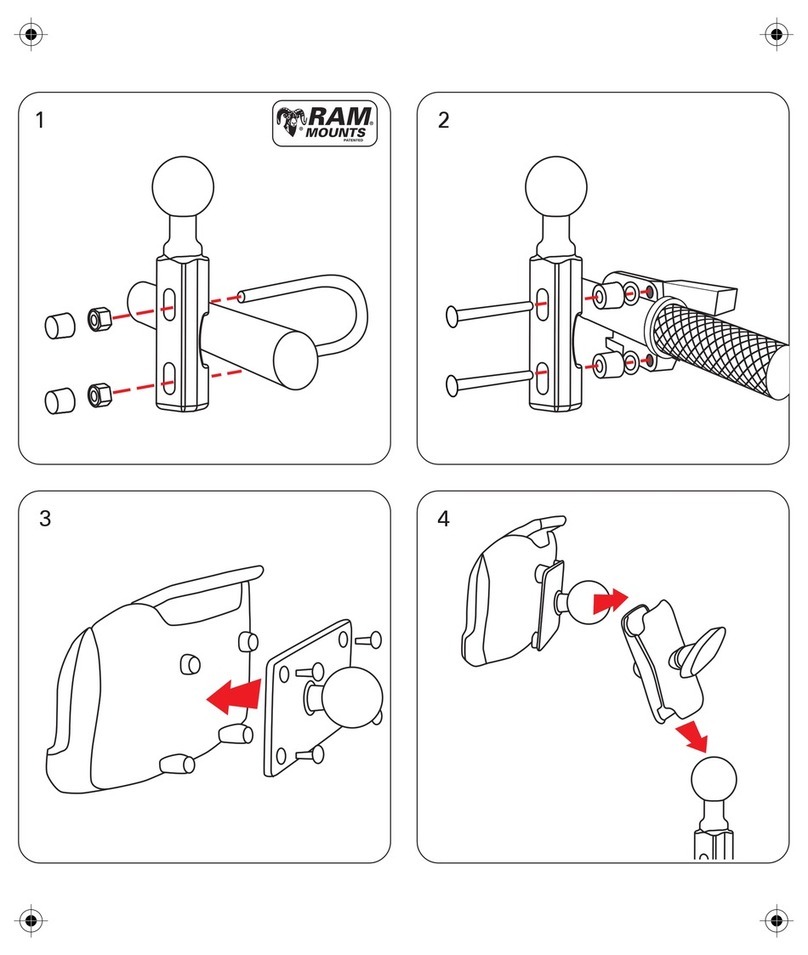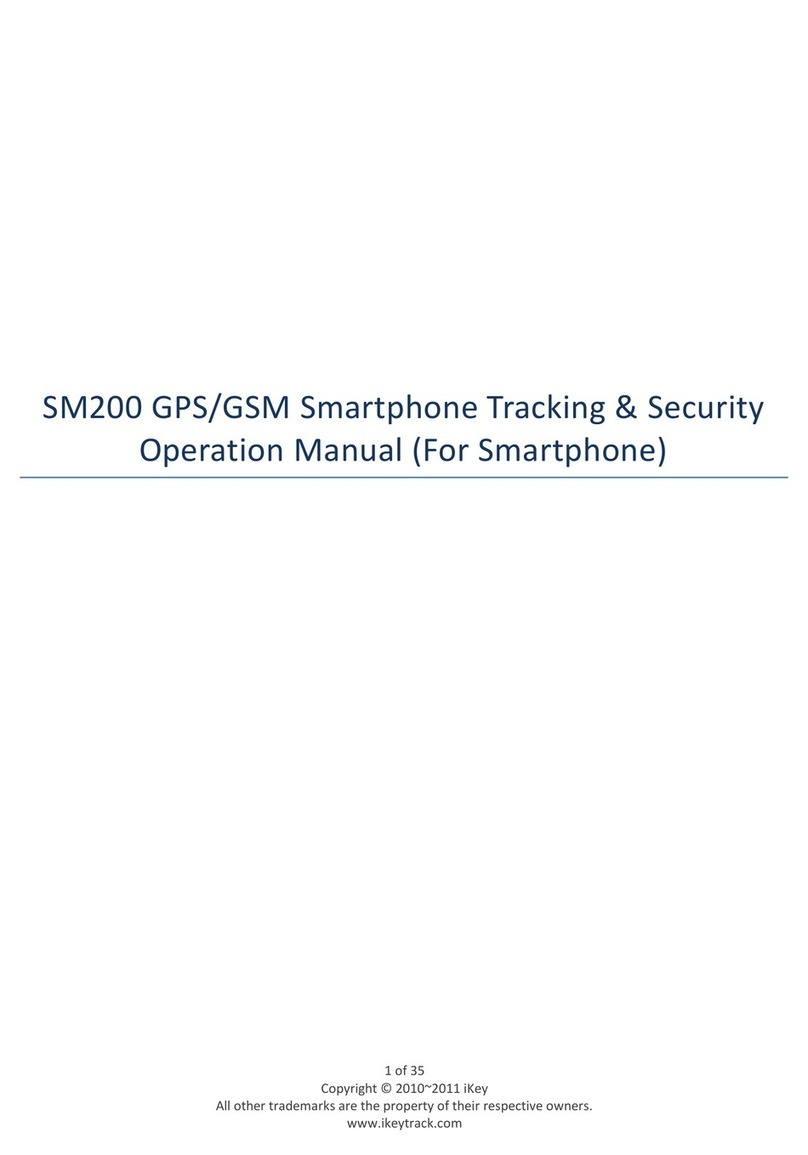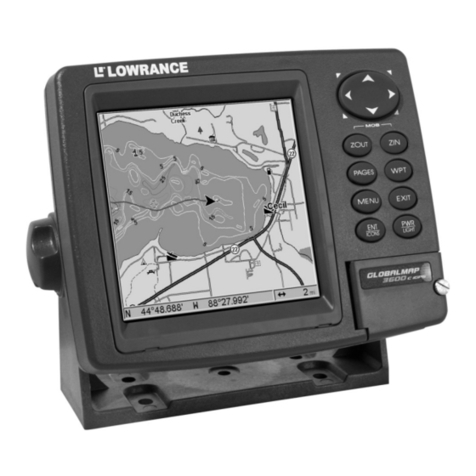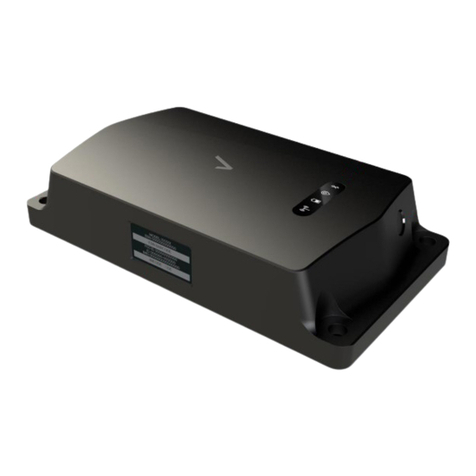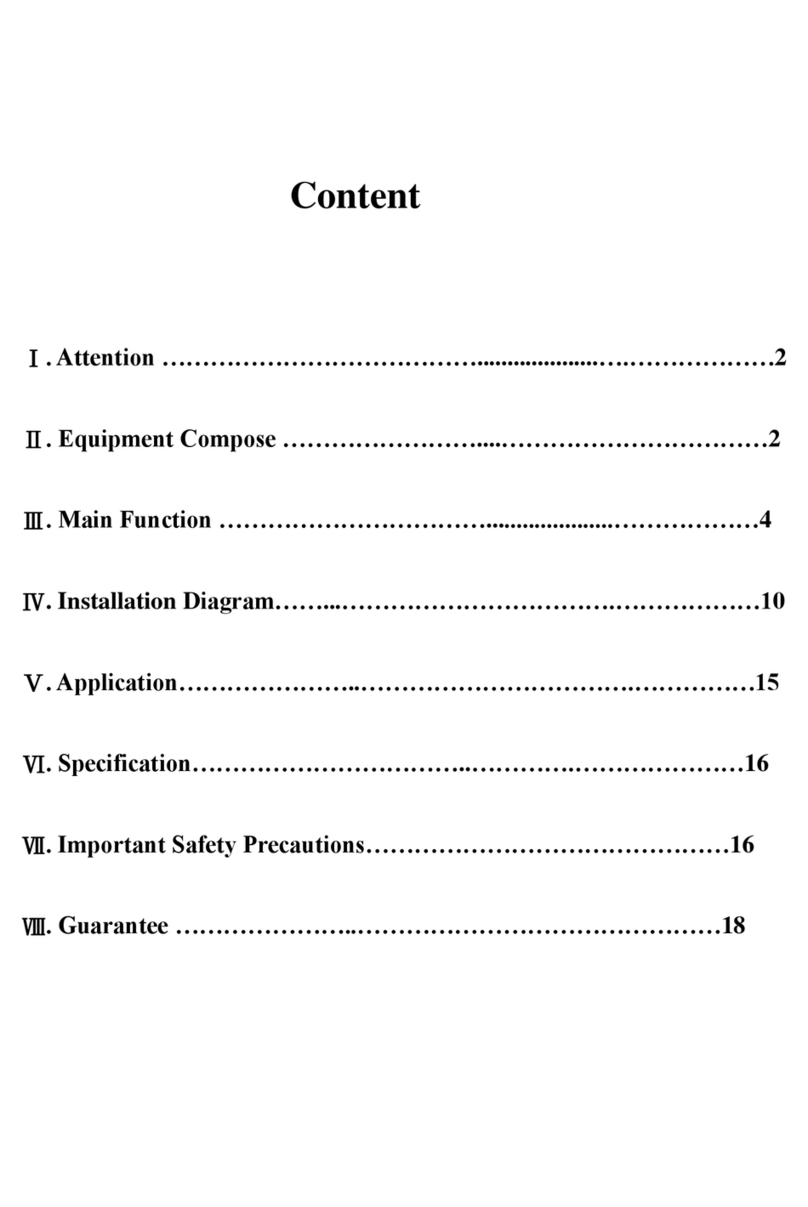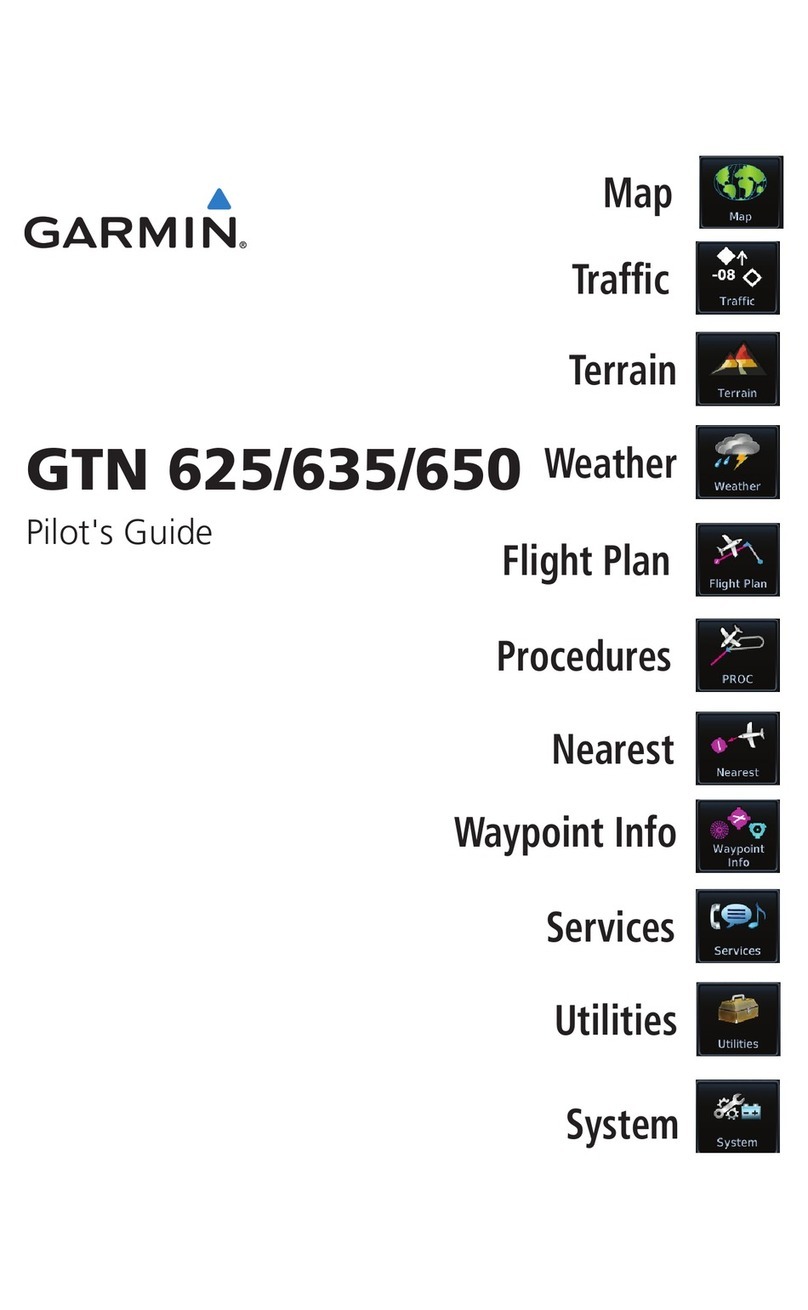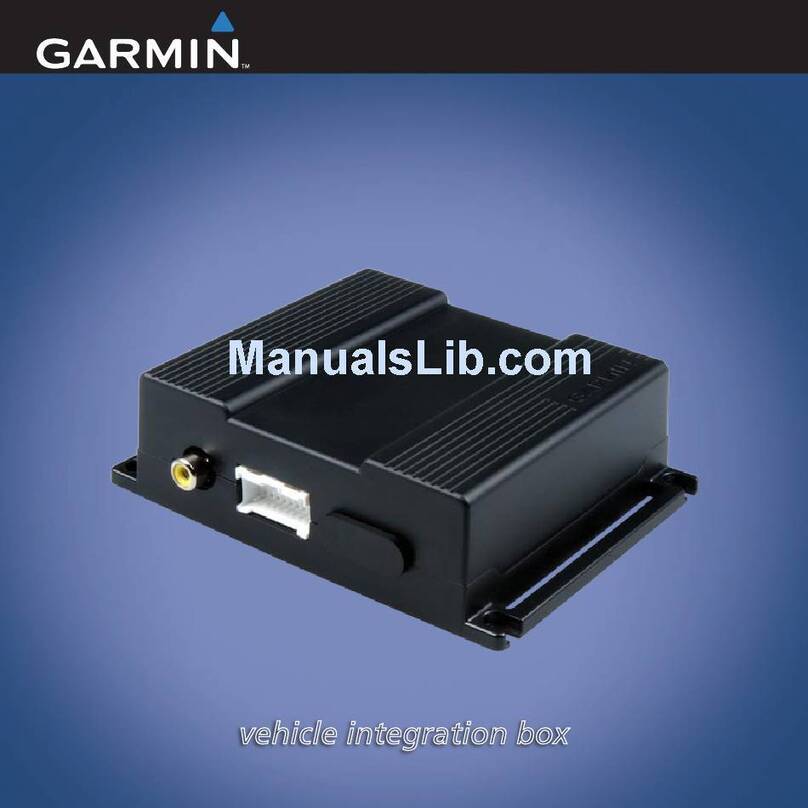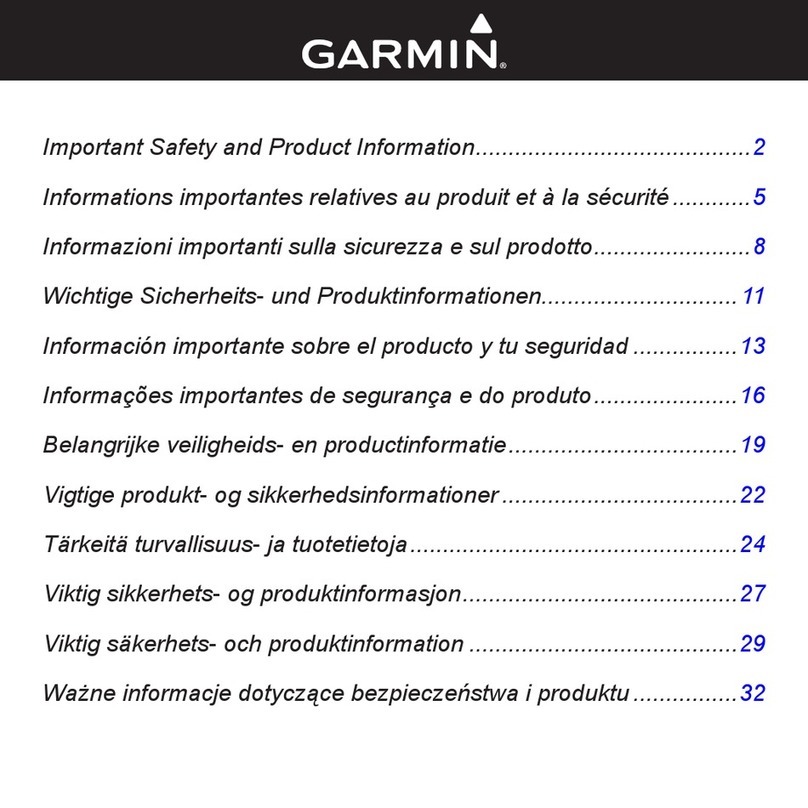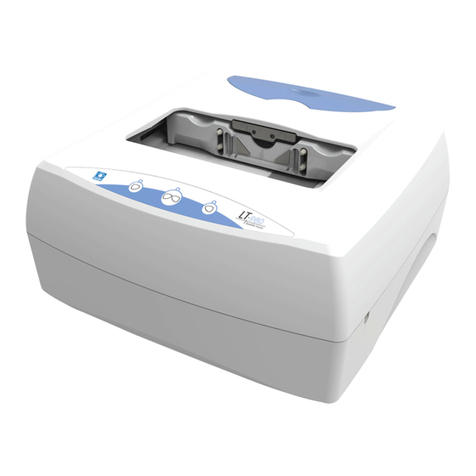Globalstar ST100 User manual

USER MANUAL
ST100
8545-0194-01 v1.0

Distribution Statements:
GLOBALSTAR CONFIDENTIAL AND PROPRIETARY INFORMATION – All data and information contained
in this document are confidential and proprietary to Globalstar, Inc. Information and instructions contained
in this publication anticipate the user possesses and applies the knowledge, training, and experience
commensurate with requirements to meet prerequisite certification.
RESTRICTIVE EXPORT NOTICE – This document may contain technical data whose export is restricted by
the Export Administration Act of 1979, as amended, Title 50, U.S.C., App 2401 et seq. Violations of these
export laws are subject to severe criminal penalties. Disseminate only in accordance with such export laws.
DESTRUCTION NOTICE – Destroy by any method that will prevent disclosure of contents or reconstruction of
the document.
Published and printed in the U.S.A. by:
Globalstar Incorporated
1351 Holiday Square Blvd.
Covington, LA 70433
Copyright ©2021 Globalstar, Inc. All rights reserved.
Globalstar®is a registered trademark of Globalstar, Inc. All other brands, product name, trademarks
and registered trademarks are properties of their respective owners. This material may not be reprinted,
republished, broadcast, or otherwise altered without the publisher’s written permission. This manual is
provided without express, statutory, or implied warranties. The publisher will not be held liable for any
damages caused by or alleged to be caused by use, misuse, abuse, or misinterpretation of the contents.
Content is subject to change without notice.
Revision date: 03/10/21

8545-0194-01 v1.0
I
TABLE OF CONTENTS
LIST OF TABLES ....................................................................................................................... V
LIST OF FIGURES ..................................................................................................................... V
1. INTRODUCTION.................................................................................................................... 1
1.1. PURPOSE ...................................................................................................................................................1
1.2. APPLICABLE DOCUMENTS ..........................................................................................................................1
1.2.1. Globalstar Documents ........................................................................................................................1
1.2.2. External References ...........................................................................................................................1
1.3. DESCRIPTION .............................................................................................................................................1
1.4. CERTIFICATIONS .........................................................................................................................................2
2. APPLICATION ....................................................................................................................... 3
2.1. THEORY OF OPERATION FOR GLOBALSTAR COMMERCIAL IoT.......................................................................3
2.2. ST100 FUNCTIONAL STATES .......................................................................................................................5
2.2.1. Pre-operational states.........................................................................................................................5
2.2.1.1. Configuration mode...............................................................................................................5
2.2.1.2. Staged for activation mode ...................................................................................................5
2.2.1.3. Activating mode....................................................................................................................5
2.2.1.3.1. Activation mode - line powered, alternative forced activation.....................................6
2.2.2. Operational states ..............................................................................................................................6
2.2.2.1. Normal operation..................................................................................................................6
2.2.2.2. Low battery operation............................................................................................................6
2.2.2.3. Extreme low battery suspend .................................................................................................6
2.2.3. End of life.........................................................................................................................................7
2.3. BLOCK DIAGRAM ........................................................................................................................................7
2.4. HANDLING OF ELECTROSTATIC SENSITIVE DEVICES ....................................................................................8
2.5. WIRING ......................................................................................................................................................8
2.6. NOISE SOURCES.........................................................................................................................................8
2.7. NORDIC PROCESSOR UNUSED PINS............................................................................................................8
2.8. OBSTRUCTIONS..........................................................................................................................................8
2.9. PCB ANTENNA ............................................................................................................................................8
2.10. EXTERNAL CONNECTIONS.........................................................................................................................9
2.10.1. External Antenna Option...................................................................................................................9
2.10.2. Battery............................................................................................................................................9
2.10.3. Solar Panel ...................................................................................................................................10
2.10.4. 14 Pin Connector...........................................................................................................................11
2.11. POWER PERFORMANCE CHARACTERISTICS.............................................................................................12
2.12. ACCELEROMETER ...................................................................................................................................13
2.12.1. Factory Hardware Configuration.......................................................................................................13
2.12.1.1. Proprietary Motion Activated Track .....................................................................................13
2.12.2. Custom Hardware Configuration.......................................................................................................13
3. GENERAL SPECIFICATIONS................................................................................................. 14

8545-0194-01 v1.0
II
4. APPLICATION PROGRAMMING INTERFACE .......................................................................... 15
4.1. ASCII COMMAND LIST AND FORMAT ..........................................................................................................17
4.1.1. ASCII Format...................................................................................................................................17
4.1.1.1. “?” ...................................................................................................................................17
4.1.1.2. “abort” ..............................................................................................................................17
4.1.1.3. “auth”...............................................................................................................................18
4.1.1.4. “bursts”.............................................................................................................................18
4.1.1.5. “ctrack”.............................................................................................................................18
4.1.1.6. “data” ...............................................................................................................................18
4.1.1.7. “dldump” ..........................................................................................................................19
4.1.1.8. “esn” ................................................................................................................................19
4.1.1.9. “fgd”.................................................................................................................................19
4.1.1.10. “firmware” ......................................................................................................................19
4.1.1.11. “gadgdata” ......................................................................................................................20
4.1.1.12. “gdvlife”..........................................................................................................................20
4.1.1.13. “ggeoframe”.....................................................................................................................20
4.1.1.14. “ghwdetail”......................................................................................................................20
4.1.1.15. “glbatrate”.......................................................................................................................21
4.1.1.16. “glgps”............................................................................................................................21
4.1.1.17. “gopmode” ......................................................................................................................21
4.1.1.18. “gpspgdump”...................................................................................................................22
4.1.1.19. “gpssnap”........................................................................................................................22
4.1.1.20. “gpstsdump” ...................................................................................................................22
4.1.1.21. “gtrackst” ........................................................................................................................23
4.1.1.22. “guid” .............................................................................................................................23
4.1.1.23. “hardware” ......................................................................................................................23
4.1.1.24. “hwversion” .....................................................................................................................23
4.1.1.25. “qpeek”...........................................................................................................................24
4.1.1.26. “qreset”...........................................................................................................................24
4.1.1.27. “raw” ..............................................................................................................................24
4.1.1.28. “reboot” .........................................................................................................................24
4.1.1.29. “runpost” ........................................................................................................................25
4.1.1.30. “setup” ...........................................................................................................................25
4.1.1.31. “sgactskip” ......................................................................................................................26
4.1.1.32. “sgadprfx” .......................................................................................................................26
4.1.1.33. “sgbattemp” ....................................................................................................................26
4.1.1.34. “sgblepar” ......................................................................................................................27
4.1.1.35. “sghltint” ........................................................................................................................28
4.1.1.36. “sglogpar” .......................................................................................................................28
4.1.1.37. “sgvltlmts”.......................................................................................................................29
4.1.1.38. “slbatrate”.......................................................................................................................29
4.1.1.39. “track” ............................................................................................................................29
4.1.1.40. “vbatt” ............................................................................................................................29
4.2. BINARY SERIAL PACKET COMMANDS ........................................................................................................30
4.2.1. Serial Packet Format........................................................................................................................30

8545-0194-01 v1.0
III
4.2.2. Serial Packet Command List .............................................................................................................30
4.2.2.1. Send Data (0x00) ...............................................................................................................31
4.2.2.2. Query Electronic Serial Number (ESN) (0x01) .......................................................................31
4.2.2.3. Abort Transmission (0x03)...................................................................................................31
4.2.2.4. Query Bursts Remaining (0x04) ...........................................................................................32
4.2.2.5. Query Firmware Version (0x05) ............................................................................................32
4.2.2.6. Setup (0x06)......................................................................................................................32
4.2.2.7. Query Setup (0x07) ............................................................................................................33
4.2.2.8. Query Hardware Version (0x09) ............................................................................................34
4.2.2.9. Set GPS Timeout command .................................................................................................35
4.2.2.10. Get GPS Timeout query .....................................................................................................35
4.2.2.11. “SPOT GEN3 emulation. ...................................................................................................35
4.2.2.12. Special consideration for “Byte 7” in the next several commands..........................................36
4.2.2.13. “Proprietary Track” command ............................................................................................36
4.2.2.14. “Proprietary Motion Activated Track” command ...................................................................38
4.2.2.15. “Update Proprietary Track Data” command .........................................................................39
4.2.2.16. “Cancel Proprietary Track/Proprietary Motion Activated Track” command................................40
4.2.2.17. “Proprietary Track Status” query ........................................................................................41
4.2.2.18. “Tracking Statistics” query ................................................................................................42
4.2.2.19. “GPS Statistics” query ......................................................................................................43
4.2.2.20. “Transmitter Statistics” query. ...........................................................................................44
4.2.2.21. “Set Accelerometer On/Off” Command. ..............................................................................44
4.2.2.22. Accelerometer On/Off Query. ..............................................................................................45
4.2.2.23. “Send Redundant Burst with GPS” command .....................................................................45
4.2.2.24. “Query Location” command...............................................................................................47
4.2.2.25. “Set Lifetime” command...................................................................................................48
4.2.2.26. “Query Lifetime Status” command .....................................................................................49
4.2.2.27. “Set Minimum Track Rate” command.................................................................................49
4.2.2.28. “Query Minimum Track Rate” ............................................................................................50
4.2.2.29. “Suspend/Unsuspend” command.......................................................................................51
4.2.2.30. Suspended State query .....................................................................................................51
4.2.2.31. “Set Low Battery Rate” command ......................................................................................52
4.2.2.32. “Query Low Battery Rate”..................................................................................................52
4.2.2.33. “Turn On GPS” command..................................................................................................53
4.2.2.34. “Turn Off GPS” command .................................................................................................53
4.2.2.35. “Turn On GPS Pass-through” command ..............................................................................54
4.2.2.36. “Turn Off GPS Pass-through” command..............................................................................55
4.3. ST100 BOARD SELF-TEST COMMAND........................................................................................................56
4.4. HEALTH STATUS MESSAGING ...................................................................................................................57
4.5. BOOTLOADING. FIELD UPDATE OF DEVICE FIRMWARE ...............................................................................58
4.5.1. Nordic Nrf52832 Firmware Update Via Bootloader (“Buttonless” DFU) ................................................58
4.5.2. On Ax50324 Firmware Update Via Serial Bootloader ..........................................................................58
4.5.2.1. 0x60 “Enter Bootloader Command” .....................................................................................58
4.5.2.2. 0x61 “Flash One Line” .......................................................................................................59
4.5.2.3. 0x62 “Enter Application” ....................................................................................................60

8545-0194-01 v1.0
IV
4.5.2.4. 0x63 “Status Query”...........................................................................................................61
4.5.3. JTAG Programming Kit .....................................................................................................................62
4.5.4. Nordic low-level load via JTAG...........................................................................................................62
4.5.5. On AX50324 Low-Level Load Via AXSEM Proprietary Programming Interface.........................................62
4.6. EXAMPLE CRC CALCULATION ROUTINES FOR SERIAL PACKETS .................................................................62
4.7. 24-BIT LOCATION FORMAT ........................................................................................................................65
4.7.1. Calculating Latitude.........................................................................................................................65
4.7.2. Calculating Longitude ......................................................................................................................65
4.8. FLASH MEMORY MAP................................................................................................................................66
5. TEST MODES...................................................................................................................... 69
5.1. HARDWIRED METHOD...............................................................................................................................69
5.2. SOFT COMMAND METHOD.........................................................................................................................70
5.2.1. Step 1: Enable the regulatory test modes. ..........................................................................................70
5.2.2. Step 2: Set the channel that you wish to perform the test on. ..............................................................70
5.2.3. Step 3: Start the desired mode. ........................................................................................................70
5.2.4. Step 4: Disable the test commands. ..................................................................................................71
5.2.5. Step 5: Restore the desired setup......................................................................................................71
6. ANTENNA TUNING GUIDANCE ............................................................................................ 72
6.1. POWER REQUIREMENTS FOR AN EXTERNAL ANTENNA TO MAINTAIN SPECIFIED EIRP...............................72
6.2. GPS / SATELLITE ANTENNA TUNING..........................................................................................................73
6.3. BLUETOOTH ANTENNA TUNING ................................................................................................................78
7. GLOBALSTAR CERTIFICATION PROCESS FOR CUSTOMER PRODUCTS................................... 79
8. GENERAL WARNINGS ........................................................................................................ 80
9. REGULATORY ..................................................................................................................... 81
10. ACRONYM LIST ................................................................................................................ 84

8545-0194-01 v1.0
V
LIST OF TABLES
LIST OF FIGURES
Table 1 - Nominal Battery Characteristics.................................................................................................................10
Table 2 - Nominal Solar Panel Characteristics ..........................................................................................................10
Table 3 - 14 pin Connector (Molex 5034801400) ....................................................................................................11
Table 4 - LP503035, 3.7V, 500mAh, Li-Polymer Battery...........................................................................................12
Table 5 - LP552535, 3.7V, 420mAh, Li-Polymer Battery...........................................................................................12
Table 6 - DTP401525, 3.7V, 110mAh, Li-Polymer Battery ........................................................................................12
Table 7 - Operating Conditions ................................................................................................................................14
Table 8 - Operating Modes & Standby Currents .........................................................................................................38
Table 9 - ST100 Test Modes ...................................................................................................................................69
Table 10 - ST100 Channels ....................................................................................................................................69
Table 11 - External Antenna Power Requirements .....................................................................................................72
Figure 1 - Board Physical Dimensions........................................................................................................................2
Figure 2 - LEO Constellation .....................................................................................................................................3
Figure 3 - Simplex Messaging ...................................................................................................................................3
Figure 4 - ST100 Block Diagram...............................................................................................................................7
Figure 5 - ST100 External Connections......................................................................................................................9
Figure 6 - Serial Packet Format...............................................................................................................................30
Figure 7 - Nordic Memory Map................................................................................................................................66
Figure 8 - Flash Layout Diagram..............................................................................................................................68

1ST100 User Manual v1 Confidential & Proprietary Information
8545-0194-01 v1.0
1.1. PURPOSE
This document describes the physical, electrical, and functional characteristics of the ST100 satellite transmitter module with
Bluetooth Low Energy. The information contained in this document is intended to provide the VAR/Integrator with the necessary
technical information required to configure and use the module in a custom application.
This document is intended to be used by engineers and technical management and assumes a general knowledge of basic
engineering practices by the user. NOTE: Globalstar is only responsible for ensuring that the ST100 Module meets the
published manufacturing specifications described herein.
1.2. APPLICABLE DOCUMENTS
1.2.1. GLOBALSTAR DOCUMENTS
GS-07-1248 - REMOTE TELEMETRY SERVICE FREQUENCY PLAN FOR SIMPLEX TRANSMITTERS
GS-07-1247 - REMOTE TELEMETRY SERVICE SIMPLEX ANTENNA SPECIFICATION AND TEST PROCEDURE
GS–02-0795 - REMOTE SIMPLEX TELEMETRY SYSTEM DESCRIPTION AND APPLICATION NOTE
GS-09-3102 - GLOBALSTAR EQUIPMENT EVALUATION APPLICATION FOR REMOTE TRANSMITTER UNIT
8545-0195-01 - ST100 APP USER GUIDE
8545-0196-01 - GLOBALSTAR ST100 PRODUCT SUBMISSION GUIDE
8545-0197-01 - ST100 QUICK START GUIDE (QSG)
1.2.2. EXTERNAL REFERENCES
Wikipedia article on Intel Hex format: https://en.wikipedia.org/wiki/Intel_HEX
NMEA-0183 rev. 3.0 Specification
FCC Guidance for Use of Radio Modules KDB 996369 D03 & D04
• Nordic Programmer (Segger):
https://www.digikey.com/product-detail/en/segger-microcontroller-systems/8-08-00-J-LINK-BASE/899-1004-ND/2175882
• ASIC Programmer (On Semi):
https://www.digikey.com/product-detail/en/on-semiconductor/AXDBG-2-GEVK/AXDBG-2-GEVK-ND/5820231
1.3. DESCRIPTION
The ST100 board is a simplex Satellite transmitter designed to send small packets of user defined data to a network of low
earth orbiting (LEO) satellites using the Globalstar commercial IoT network. The received data is then forwarded to a user
defined network interface that may be in the form of an FTP host or HTTP host where the user will interpret the data for further
processing. The ST100 board must be powered by a battery, or line-powered by a DC source. The ST100 Board features a
solar charging circuit that allows battery charging from an attached solar panel. The unit will not power from a solar panel
alone, without a battery. The ST100 board contains a satellite transmitter, GPS receiver, motion sensor, Bluetooth Low Energy
transceiver, solar charger, and printed circuit antennas for each of the radio subsystems. The ST100 board has u.FL connectors
on the outputs of the Bluetooth transceiver and GPS receiver / satellite transmitter, which give the user the option to use
external antennas.
1. INTRODUCTION

2ST100 User Manual v1 Confidential & Proprietary Information
8545-0194-01 v1.0
The ST100 board also has the option for the user to use an external serial port.
Under VAR setup and configuration, and normal use by the end user, communication with the device is via a Bluetooth Low
Energy (BLE) GATT/Modem interface with a mixture of ASCII and binary command/query protocols. The ST100 PCB weighs
~6.2g (with shield, no battery, no solar panel), with the dimensions shown below:
1.4. CERTIFICATIONS
Our products comply with WEEE and RoHS. The ST100 has the following certifications:
• Bluetooth LE
• FCC
• ISED
• CE RED
FIGURE 1 - BOARD PHYSICAL DIMENSIONS

3ST100 User Manual v1 Confidential & Proprietary Information
8545-0194-01 v1.0
2. APPLICATION
2.1. THEORY OF OPERATION FOR GLOBALSTAR COMMERCIAL IoT
The ST100 Board operates on the Globalstar LEO satellite network. LEO (Low Earth Orbit) means that there are a number of
satellites in low earth orbit that constantly orbit the planet and can communicate with Globalstar devices that are within range of
its current position.
Because the satellite position is constantly changing, commercial IoT devices on the ground will transmit (with no knowledge
of any of the satellites locations) and the transmission may be received by one or more satellites. These satellites will then relay
the message to the nearest satellite gateway (Figure 3). Once received by the satellite gateway, the simplex message will be
delivered to the simplex gateway where redundant messages are discarded and the data from the message is sent to the OEM
via the Internet.
FIGURE 2 - LEO CONSTELLATION
FIGURE 3 - SIMPLEX MESSAGING

4ST100 User Manual v1 Confidential & Proprietary Information
8545-0194-01 v1.0
Messages are composed of 1 or more 9-byte payloads. The user application may send a message via the Bluetooth Low Energy
interface to the ST100 board from 1 to 144 bytes in length. The ST100 board will break the message into 9 byte packets. A 144
byte message would be divided into 16 packets.
There are brief periods of time where there is no satellite in range of the commercial IoT transmitters due to obstructions
and/ or satellite coverage geometry. Since a commercial IoT device has no way of knowing if a transmitted message has been
successfully received, the ST100 Board is designed to send multiple (redundant) transmissions for each message sent over the
Globalstar network.
The default value for the number of redundant transmissions per message is 3. This means that each message sent to the
ST100 Board will normally be transmitted 3 times. Each transmission will contain the exact same data payload. The redundant
transmissions of each message will be sent on a randomized interval with a configurable maximum and minimum duration.
The default re-transmission configuration occurs between 5 to 10 minutes apart for each even randomized distribution. The
transmission sequence for a single-packet message using the default setting of 3 redundant transmissions is shown below.
The transmission sequence for a two-packet message using the default setting of 3 redundant transmissions is shown below.
For normal conditions where the transmitter has an open view of the sky, this will result in a better than 99% chance that the
message will be received.

5ST100 User Manual v1 Confidential & Proprietary Information
8545-0194-01 v1.0
2.2. ST100 FUNCTIONAL STATES
Over the ST100’s lifetime, it transitions through the following states.
2.2.1. PRE-OPERATIONAL STATES
Note that these states are conceptual, rather than hard “states” that the device can be commanded to be in directly. They are
defined by events that have occurred prior to the device becoming fully operational.
2.2.1.1. Configuration mode
This describes the state in which the unit leaves the factory. No operational profile and no lifetime have been programmed into
it. The unit’s solar panel has not been uncovered and the battery has not been allowed to charge. The VAR transitions the unit
to be staged for activation mode by setting a lifetime and a profile into the unit, as described in the section below.
2.2.1.2. Staged for activation mode
The device is considered to be in staged for activation mode when the following things have been programmed.
• Device lifetime in months.
• A reporting profile: This is set using the “track” command. (See section on ASCII commands). The track command
takes arguments for the reporting interval in minutes, and the values of the user programmable bytes (bytes 0, 7, and
8) of the on-air message.
• Optional: GPS fix timeout. The unit comes from the factory with a GPS fix timeout of 4 minutes. Note, this is the
MAXIMUM time it will attempt to obtain a GPS fix before giving up for that report cycle. If a fix is obtained in less time
(about 40 seconds is typical with a good view of the sky) the unit will de-power the GPS as soon as a fix is obtained.
Leaving this value at the factory default of 4 minutes is strongly recommended for GPS reliability.
• Optional: A low battery report rate. This is the report rate the ST100 drops to when the battery voltage is below 3.6
volts. The unit is shipped from the factory with this value set to 24 hours (one transmission per day). If the VAR desires
a different value here, it may be set via the “slbatrate” command.
• Note, the low battery rate MUST be greater than the normal rate. If, for example, the VAR intends to set the normal
reporting rate to 24 hours (via the “track” command) he must first set the low battery rate to greater than 24 hours,
and then issue the track command. While not required, it is recommended that the low battery rate be a multiple of
the normal track rate. For example, a common configuration is to set the track rate to 6 hours and the low battery
rate to 24 hours (4 times the track rate).
2.2.1.3. Activating mode
The unit enters this mode when it detects that the unit is apparently in sunlight and the battery is charging, defined as a positive
current flow into the battery for 5 consecutive minutes.
NOTE: A minimum amount of sunlight may be required for the solar panel to begin charging the battery, in order to enter
the activating mode. If sunlight is not available (cloudy day), the device can be commanded to enter the activating mode.
Once charging of the battery is detected, the unit will attempt to obtain a GPS fix. If the fix is not obtained within the GPS
timeout, the unit will sleep for 5 minutes and try again. This cycle will continue until a fix is successfully obtained. This cycle will
“pause” if the battery level drops below 3.4 volts and resume after it has had some time to charge.

6ST100 User Manual v1 Confidential & Proprietary Information
8545-0194-01 v1.0
NOTE: If charging for 5 consecutive minutes is detected, the likelihood is extremely high that the unit is outside, and the GPS
fix will be obtained on the first attempt. The retry cycle is an edge case exception in operation.
Once the unit obtains a GPS fix, it calculates its expiration date, based on the lifetime previously programmed, and enters
operational mode.
2.2.1.3.1. Activation mode - line powered, alternative forced activation
For line powered units, the battery charging detection portion for this process can be skipped by issuing the “sgactskip”
command during setup. If this command is issued, the GPS fix step below will commence when line power is applied. If you are
unable to activate the ST100 (due to low sunlight conditions) bypass the activation algorithm to instantly activate the unit using
the following steps: Note, this does not mean that the unit will start transmitting even if the battery is low. It will still stick to its
power & temperature mode behaviors.
1. Login, connect to the device, and access the Diagnostics screen to enter commands (Full instructions on how to access the
screen can be found in Section 4).
2. Skip the activation:
• Send command “sgactskip 1 1”
3. Reboot the BLE processor:
• Send command “reboot”
4. Verify the ST100 is in the Activated mode:
• Send command “gopmode”
2.2.2. OPERATIONAL STATES
These are the states the unit may be in after finishing “activating mode” described above.
2.2.2.1. Normal operation
The unit is in normal operation executing its track profile any time the battery voltage is above 3.6 volts.
2.2.2.2. Low battery operation
The unit will execute a track profile, but at the reduced “low battery” rate, when the battery voltage is below 3.6 volts but above
3.4 volts.
2.2.2.3. Extreme low battery suspend
When the battery voltage is below 3.4 volts, the unit will completely suspend operation, entering a “hibernate” state to allow the
battery to charge.

7ST100 User Manual v1 Confidential & Proprietary Information
8545-0194-01 v1.0
2.2.3. END OF LIFE
When the unit auto activates, it calculates an end date based on its programmed lifetime. For example, if the lifetime is 3 years
(36 months) and it activates on October 24, 2020, the expiration date will be October 24, 2023.
Each time the unit obtains a GPS fix, it checks the calendar date. If the date is past the expiration date (in this example, October
25, 2023) it immediately drops out of track mode and enters end of life mode.
Once the unit has entered end of life mode, it will respond to simple queries, such as a query for its version number or tracking
state (which will be “none”), but it will NAK any command that might cause it to transmit over the Globalstar network, such as
commands to put it back into a track mode or to send a custom message.
2.3. BLOCK DIAGRAM
The ST100 is configured at the factory to cutoff charging at temperatures below -30°C and above 85°C. These cutoff points are
configurable via the “sgbattemp” command over a range of -30°C to 85°C. It is imperative that these temperatures match
those recommended for the battery or a fire hazard could result!
The battery fully charged voltage cutoff is 4.08 volts.
FIGURE 4 - ST100 BLOCK DIAGRAM

8ST100 User Manual v1 Confidential & Proprietary Information
8545-0194-01 v1.0
2.4. HANDLING OF ELECTROSTATIC SENSITIVE DEVICES
Some components on the ST100 PCB are sensitive to electrostatic discharge (ESD). The following general guidelines can help
reduce damage due to ESD.
1. Use a grounding bracelet if possible, to minimize charge build-up on personnel.
2. Handle the ST100 PCB by the long edges without touching components or printed circuit paths. The long edges measure
approximately 2" (50.8mm). The short edges measure approximately 1" (25.4mm). NOTE: There are ESD sensitive devices
located closer to the short edges than the long edges.
3. Store the ST100 PCB in static sensitive packaging whenever possible.
NOTE: Failure to adhere to ESD guidelines will void the product warranty.
2.5. WIRING
If the ST100 will be line-powered, proper installation and field wiring practices are important to follow. Users and installers
should familiarize themselves with the requirements of all applicable codes, laws, and standards.
2.6. NOISE SOURCES
Electrical noise is an important consideration in any installation of the ST100. When possible, sufficient physical separation
should be maintained between electrical noise sources and the ST100.
2.7. NORDIC PROCESSOR UNUSED PINS
Due to its sensitivity to IR light, the Nordic processor is covered with opaque, light-blocking epoxy.
Tests have shown that if unused pins on the Nordic processor are set as input without internal pulldowns enabled, the epoxy
will cause higher current draw in low power mode.
It is strongly advised to not leave unused Nordic pins at high impedance (input without internal pulldown).
2.8. OBSTRUCTIONS
If the internal ST100 Bluetooth and/or GPS/Satellite antennas are used, care should be taken as to what is placed above,
below, and around the short edges of the PCB. The short edges are where the ST100 internal antennas are located. For best
performance, the ST100 should have an unobstructed view of the sky, either outdoors or in a glass-enclosed area such as a
vehicle dashboard.
2.9. PCB ANTENNA
REGULATORY NOTE: The ST100 was certified with its Satellite and Bluetooth PCB Trace antennas. Use of any external
antenna will require additional regulatory testing.

9ST100 User Manual v1 Confidential & Proprietary Information
8545-0194-01 v1.0
2.10. EXTERNAL CONNECTIONS
The picture (below) depicts the PCB external interfaces.
2.10.1. EXTERNAL ANTENNA OPTION
The ST100 has provisions where an external antenna can be used on either the Bluetooth and/or the GPS/Satellite antennas. If
an external antenna is used, care should be taken when connecting the external antenna to the u.FL connector - Hirose part #
U.FL-R-SMT(10) on the ST100 PCB. If this option is desired, Globalstar needs to know before boards are ordered.
2.10.2. BATTERY
The ST100 has terminals on the PCB where a battery can be soldered to. The user / installer should carefully note the location
of the positive and negative terminals marked on the PCB and solder the battery accordingly. It will be up to the user / installer
to verify the power requirements (see Table 7 - Operating Conditions). NOTE: RoHS-compliant and lead-free solder must be
used in order to maintain the RoHS-compliance of the ST100.
The ST100 can be powered in the following configurations:
1. Line powering with a 3.4V to 5.5VDC source to the battery terminals. The source must meet the requirements specified
(see Table 7 - Operating Conditions).
2. Connecting a battery to the battery terminals and connecting a 0.75V to 5VDC source to the solar terminals. The source on
the solar terminals must meet the requirements specified (see Table 7 - Operating Conditions).
FIGURE 5 - ST100 EXTERNAL CONNECTIONS
BATTERY (-) TERMINAL
BATTERY (+) TERMINAL
SOLAR (-) TERMINAL
SOLAR (+) TERMINAL
GPS/SATELLITE U.FL CONNECTOR
14 PIN CONNECTOR

10ST100 User Manual v1 Confidential & Proprietary Information
8545-0194-01 v1.0
Notes:
1. This list is not a complete list of acceptable batteries. These are batteries that Globalstar has identified and tested as
acceptable.
2. The VAR/installer should review the pairing of solar panel/battery and determine if the solar panel is adequate for use with
the selected battery.
3. If a battery is used, it will be the responsibility of the VAR/installer to verify the relevant battery approvals/certifications for
where the end-product will be used (i.e. IEC62133 approval).
4. Due to the solar charger chip’s 100mA max input current, the max recommended battery size is 500mAh.
2.10.3. SOLAR PANEL
The ST100 has terminals on the PCB where a solar panel can be soldered to. The user/installer should carefully note the
location of the positive and negative terminals marked on the PCB and solder the solder panel accordingly. It will be up to the
user/installer to verify the solar power requirements (see Table 7 - Operating Conditions: Power Requirements).
NOTE: RoHS-compliant and lead-free solder must be used in order to maintain the RoHS-compliance of the ST100.
MANUFACTURER
/ PART # DESCRIPTION PROTECTION
CIRCUIT INCLUDED
IEC62133
APPROVALS DIMENSIONS NOTES
PK Cell part # LP503035 3.7V, 500mAh,
Li-Polymer Yes Yes 35 x 30 x 5mm
+/- 0.1mm
Battery is normally stocked with
a connector attached, but can be
ordered without connector
PK Cell part # LP552535 3.7V, 420mAh,
Li-Polymer Yes No 35 x 25 x 5.5mm
+/- 0.1mm
Battery is normally stocked with
a connector attached, but can be
ordered without connector
Data Power Technology
Limited part # DTP401525
3.7V, 110mAh,
Li-Polymer Yes No 25 x 15 x 4mm
+/- 0.1mm Battery will only work down to 0°C
MANUFACTURER
/ PART # DESCRIPTION
VOC
(open-circuit
voltage)
VMPP
(max power point)
ISC
(short-circuit
current)
TYPICAL FULL-SUN CURRENT
AVAILABLE FOR CHARGING
THE BATTERY (Note 3)
DIMENSIONS
PowerFilm part # 2.4V
94x73mm BSC
2-cell, 2.4V,
288mW 3.6V 2.4V 140mA 50-60mA 94 x 73 x 0.8 mm
PowerFilm part #
SP2.4-37
4-cell, 2.4V,
54mW 3.6V 2.4V 30mA 7-11mA 50 x 36.5 x 0.8 mm
PowerFilm part #
SP2.4-37
5-cell, 2.4V,
67.5mW 4.5V 3V 30mA 10-14mA 60 x 36.5 x 0.8 mm
IXYS part #
SM111K06L
High Efficiency,
3.35V, 156mW 4.15V 3.35V 46.7mA 20-30mA 42 x 21 x 2 mm
IXYS part #
SM451K08L
High Efficiency,
4.46V, 370mW 5.53V 4.46V 187mA 70-75mA 89 x 55 x 2 mm
TABLE 1 - NOMINAL BATTERY CHARACTERISTICS
TABLE 2 - NOMINAL SOLAR PANEL CHARACTERISTICS

11ST100 User Manual v1 Confidential & Proprietary Information
8545-0194-01 v1.0
Notes:
1. This list is not a complete list of acceptable solar panels. These are panels that Globalstar has identified and tested as
acceptable.
2. The VAR/installer should review the pairing of solar panel / battery and determine if the solar panel is adequate for use with
the selected battery.
3. This value is based on the efficiency of the solar charger chip, which is typically 80-85%.
4. The solar panel should be chosen for outdoor use, if the end-application will be mostly outdoors.
5. For the 140mAh solar panel, under ideal conditions, it would take ~ 10 hours to recharge a fully discharged 500mAh
battery (listed in the Power Performance Characteristics tables).
2.10.4. 14 PIN CONNECTOR
The ST100 is equipped with a 14 pin connector to provide access to serial connection, ASIC programming and Bluetooth
processor programming using external breakout/debug tools.
PIN # FUNCTION SIGNAL NAME DESCRIPTION NOTES
1
Bluetooth processor
programming through JTAG
3V0 3V supply The 3V supply is only meant to power loads
less than 20mA.
2 SWDIO Bluetooth processor programming line
3 GND PCB Ground
4 SWDCLK Bluetooth processor programming line
5
ASIC Programming
GND PCB Ground
6 SAT_DBG_DATA ASIC programming line
7 SAT_DBG_CLK ASIC programming line
8 SAT_DBG_EN ASIC programming line
9 SAT_RST_N ASIC reset
10
Serial connection
EXT_TX_CONN External Serial Port Transmit This is the Receive signal on the Bluetooth
processor.
11 EXT_RTS_CONN External Serial Port Request to Send This is a GPIO signal connected to the
Bluetooth processor.
12 Bluetooth processor
programming through JTAG MCU/BLE_#RESET Bluetooth processor reset
13
Serial connection
EXT_CTS_CONN External Serial Port Clear to Send This is a GPIO signal connected to the
Bluetooth processor.
14 EXT_RX_CONN External Serial Port Receive This is the Transmit signal on the Bluetooth
processor.
TABLE 3 - 14 PIN CONNECTOR (MOLEX 5034801400)

12ST100 User Manual v1 Confidential & Proprietary Information
8545-0194-01 v1.0
NOTE:
1. The mating cable for Molex 5034801400 is Molex part # 0152660153, or equivalent.
2. The max voltage level on all pins is 3.3V.
3. It is possible to share the UART with two different entities. First, make sure that no UART communication is planned from
the Nordic to the ASIC then, un-initialize the UART from the ASIC Tx & Rx Pins. Following this, reinitialize the UART to the
external connector Tx & Rx Pins. It is highly recommended to keep it to Nordic-ASIC configuration by default and at any
time that it is not in use.
2.11. POWER PERFORMANCE CHARACTERISTICS
The ST100 battery performance heavily depends on the amount of GPS and Satellite Transmitter usage. Below are some
examples of battery performance for select battery sizes and track modes.
NOTE: 50mW (minimum) is required to recharge a discharged battery
NOTE: The data gathered above represents messages with a size of 1 data packet.
TABLE 4 - LP503035, 3.7V, 500MAH, LI-POLYMER BATTERY
TABLE 5 - LP552535, 3.7V, 420MAH, LI-POLYMER BATTERY
TABLE 6 - DTP401525, 3.7V, 110MAH, LI-POLYMER BATTERY
TEST MODE EXPECTED BATTERY LIFE
(without charging the battery)
30 minute track mode 8.5 days (tested)
60 minute track mode 16.5 days (tested)
240 minute track mode 49 days
360 minute track mode 67 days (tested)
720 minute track mode 100 days
1440 minute track mode 140 days
TEST MODE EXPECTED BATTERY LIFE
(without charging the battery)
30 minute track mode 5.5 days (tested)
60 minute track mode 10.5 days
240 minute track mode 34 days
720 minute track mode 72 days
1440 minute track mode 100 days
TEST MODE EXPECTED BATTERY LIFE
(without charging the battery)
30 minute track mode 1.5 days
60 minute track mode 3 days
240 minute track mode 10 days
720 minute track mode 19 days
1440 minute track mode 28 days

13ST100 User Manual v1 Confidential & Proprietary Information
8545-0194-01 v1.0
2.12. ACCELEROMETER
2.12.1. FACTORY HARDWARE CONFIGURATION
The ST100 is shipped from the factory with the Accelerometer connected to the ASIC processor.
Rather than issue the normal “track” command, during configuration, the VAR may issue the binary command “Proprietary
Motion Activated Track”. This will cause the ASIC to use the accelerometer for motion detection.
Custom Nordic firmware written by the VAR using the Globalstar ST100 SDK may also be used to invoke this special track
mode. All interface to the ASIC processor from such custom code is via the binary serial packed commands described in
section 4.2.
2.12.1.1. Proprietary Motion Activated Track
In this mode, the ST100 uses the same proprietary motion detection algorithm as the SPOT branded SPOT Gen3, SPOT Gen4,
SPOT Trace, and SPOTX products. Track reporting is suspended when the accelerometer indicates that the device is not
moving and operates when the accelerometer indicates that the device is moving. This is the mode that is the default mode on
the SPOT branded products listed here. (These products do not offer non-suspending track, which is the most common mode
used in the ST100).
2.12.2. CUSTOM HARDWARE CONFIGURATION
The ST100 can be ordered with the I2C lines and interrupt lines of the accelerometer routed to the Nordic processor. With
this special order, the customer is expected to write custom code using the ST100 SDK to implement whatever algorithm he
chooses on the accelerometer.
• In this configuration, the Nordic processor has direct control of the accelerometer.
• The accelerometer is an ST Micro LIS3DH. The user must program and access it directly.
• Data sheets and programming guides for the accelerometer are available at:
https://www.st.com/en/mems-and-sensors/lis3dh.html
Note, however that the ASIC has control over the accelerometer’s power. The custom code written by the VAR using the SDK
must turn the accelerometer on and off using the “Turn Accelerometer On/Off” command (see section 4.2. BINARY SERIAL
PACKET COMMANDS, page 30).
Other manuals for ST100
2
Table of contents
Other Globalstar GPS manuals
